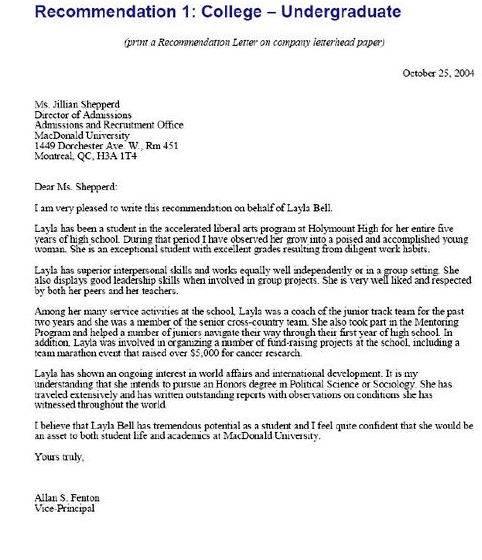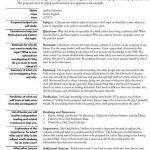GSAS GUIDE FOR TEACHING FELLOWS ON WRITING LETTERS OF RECOMMENDATION
by Cynthia Verba
Writing letters of recommendation is a skill that will be of great importance throughout your teaching career, and perhaps should be viewed as an almost integral part of your teaching experience. Students in your sections or tutorials who have had a positive experience – in terms of what they have learned, or the work they have produced – are likely to come to you for a letter of recommendation. Indeed, an abundance of requests can be taken as an indication that you are a good teacher and have an ability to establish a rapport with your students. In our view, good letter writers deserve considerable recognition for the contribution that they make. (If you have written a large number of letters, you might even consider making a note of that when asked by a potential hiring department about your teaching skills and responsibilities.)
l. In simplest terms, a letter of recommendation is a letter that makes a statement of support for a candidate. If, after doing a careful review of a candidate’s strengths and weaknesses, you cannot write a supportive letter, it is important to have a candid discussion with the student.
2. Beyond that simple definition, a letter of recommendation should also present a well-documented evaluation, providing sufficient evidence and information to help a selection committee in making its decision.
3. A letter of recommendation should also address the specific purpose for which it is written – although you will also receive requests from many students for a general letter for their House file, in anticipation of eventual applications.
For most applications, a letter of recommendation will need to discuss both scholarly capabilities and personal character – although the balance between the two will vary, depending upon the nature of the application. For example, at one end of the scale, a letter for an applicant for graduate study in the arts and sciences should focus primarily on the scholarly, while at the other end, a letter for an applicant for a non-academic position should discuss a broader range of qualities and experiences – including extracurricular or work experience as well. As a further example of matching a letter with its purpose, a letter for an applicant for a fellowship with a specific project should discuss the validity and feasibility of the project, as well as the candidate’s qualifications for fulfilling the project. The letter should pay close attention to the language of the fellowship announcement.
If you have any questions about the criteria for a specific application, consult the appropriate specialists – for example, those who do pre-law, medical, business or fellowship advising at the Office of Career Services or in the Harvard Houses.
4. A letter of recommendation can also be used to explain some weakness or ambiguity in a student’s record. If appropriate – and probably after consulting the student – you might wish to mention a family illness, financial hardship, or other factor.
5. For the content of a well-documented letter, the following are further suggestions (see also the samples in the final section):
a. You should promptly identify yourself and the basis of your knowledge of the student: Were you a Teaching Fellow in a tutorial or small seminar for department concentrators? How often did it meet, how many students? how many papers? Do you also know the student through exposure as a House Tutor, or some other capacity? Has your acquaintance been sustained over a number of years? Writing the letter on department letterhead is a further form of identification.
b. In evaluating a student’s intellectual capabilities, try to describe the student in terms that reflect that student’s distinctive or individual strengths. Whatever strengths strike you as particularly salient, be prepared to back up your judgement with concrete examples – papers, exams, class presentations, or performance in a laboratory.
Above all, avoid the misconception that the more superlatives that you use, the stronger the letter. Heavy use of stock phrases or cliches in general is unhelpful. Your letter can only be effective if it contains substantive information about the student’s qualifications.
c. Ranking the student may be requested or desired by selection committees. Having concentrated on the student’s individual or unique strengths, you might find it difficult to do so. Ranking is of course less of a problem if a student is unambiguously among the top five or ten percent that you have taught, or so outstanding that he or she would safely rank high in any group. Many of the students who come to you for a letter, however, will not fall within that small unambiguous group. If you wish to offer some comparative perspective, you might be more readily able to do so in more specific areas: Is the student one of the most articulate? original? clear-thinking? motivated? intellectually curious? Some schools or fellowships have forms which ask for rankings broken down into specific areas.
If you lack sufficient information to answer some questions posed or suggested in an application, it is best to maintain the integrity and credibility of your letter, and say only what you are in a position to say.
d. In discussing a student’s character, proceed in a similar fashion to the intellectual evaluation, highlighting individual traits and providing concrete illustrations.
e. After discussing each of the above points, your letter should have some brief summation, giving the main thrust of your recommendation for the candidate.
Even if you know a student very well, the process of writing an effective letter can be greatly facilitated if you arrange to have an interview with the student, using this as an opportunity to discuss the student’s goals – short-term and long – and to acquire more precise information in any area where it is needed.
As you arrange a meeting with a student, you should also ask the student to bring the following items:
1) a resume or curriculum vitae,
2) a paper or an exam written for your course,
3) a copy of the application essay or fellowship statement of purpose
5) any literature that describes the fellowship or program for which the student is applying; specific recommendation forms or questionnaires if they are provided for the letter writer to complete
6) the date on which the recommendation is due, as well as the address – preferably an addressed envelope to which it must be sent
7) a waiver form (obtained by the student from the House Senior Tutor), indicating whether or not the student waives his or her right to see the letter of recommendation. If the student has any questions about this decision, you might point out that there are important benefits in maintaining the confidentiality of letters. Selection committees, for example, tend to view confidential letters as having greater credibility and assign them greater weight; also, some letter writers actually feel less inhibited in their praise of students in confidential letters. While making these points, be sure to make it clear that it is up to the student to decide.
One other factor that greatly facilitates letter writing is if you can write a letter as soon as possible after you have taught a student, while your impressions are still vivid and fresh. You might consider encouraging students to make their requests early, rather than waiting until senior year or beyond. These early letters can be placed in the students’ House files, as well as maintained in your own files for future reference.
The written materials listed above and a discussion with the student will greatly benefit the letter writing process – and indeed, the application process – although in each case it will benefit in a different way. The following are possible scenarios:
The easiest case: A request is made by a student you know very well, have seen in different settings – classroom and House – and whose performance and conduct you find to be consistently outstanding. In this case, you can use the discussion and written materials not only to further refine your own presentation of the student, but to help the student refine the application – and especially the application essay. Many students find it difficult to talk about themselves – even the most articulate. By drawing the student out, asking for further elaboration or more specific details, you can help bring into sharper focus such items as past accomplishments, future plans, or why the student is making this particular application.
The in-between case: A request is made by a student who has made some favorable impression, but you lack considerable information to write a well-documented letter. The benefits of the interview and acquiring written materials are most obvious in this instance. In addition to allowing you to do all of the above, they will allow you to fill in gaps in your knowledge and to gain a clearer view of the candidate. It is particularly helpful for students who tend to be somewhat shy or quiet in class. What you may not have learned about the student in the classroom, you may be able to learn through a discussion that specifically addresses matters that you need to know.
The most difficult case: A request is made by a student who has made no impression, or only a negative impression. In this case, it is extremely important to be both candid and helpful at the same time. One of the things a discussion can accomplish is to give the student a thorough hearing before you decide whether or not you can provide support. If you still find that there is little that you can say in support, you might help the student to identify a more appropriate letter writer, and also explore whether the student is making an appropriate application.
Such a discussion offers an important teaching and advising opportunity – one that may be sorely needed. The student who comes to you for a letter that you cannot write may have a similar problem with other instructors. It is important to discuss with the student how he or she might improve prospects for the future. Above all, it is important to avoid allowing the student to believe that all opportunities have been permanently closed. Try to emphasize the student’s potential strengths – perhaps asking the student to share with you a favorite paper or other positive experience that may have occurred outside of your class. The message to convey is that there are constructive steps to be taken, and that if the student has gained a clearer understanding of his or her strengths and weaknesses, then this marks an important first step.
In some applications, the format is determined by the application itself: the recommender is asked to answer a series of questions. If a form does not allow you to say everything that you would like to say, it is appropriate to attach additional remarks. Indeed, it is common practice to attach a full letter of recommendation to a form, in addition to responding to questions on the form. Furthermore, if a form asks for information that you cannot provide, it is best to say so. The following are further considerations:
l. The length of a letter: If you follow the above guide-lines, your letter probably will be somewhere between one and two pages. Anything longer than three pages is counter-productive, since readers normally have a quantity of letters to read. On the other hand, anything shorter than a page may imply a lack of interest or knowledge about the student.
2. The care with which you write the letter: This will also influence the effectiveness of the letter. Writing in your best polished prose style is another way of registering your support for the student.
3. Clarification of terms peculiar to Harvard: Terms such as “Tutorial” require some explanation. It may mean that you taught the student in a small seminar, or perhaps you provided individual supervision for the student’s thesis. Similarly, if your primary contact with the student is through your role as a House Tutor, it is important to explain that role. It may be useful to clarify that the Harvard Houses are more than dormitories and that they perform academic functions as well.
4. Writing the letter on a word-processor: If possible, do so, and be sure to save the file. Once you have been asked by a student to write a letter, that student may return again and again, over a large number of years, for additional letters. A word-processor allows you to adapt and up-date an original letter with considerable ease. It is a way of protecting your initial investment in time and effort.
5. To whom to address the letter: If a student is applying to similar programs in a number of different schools, your letter can be left virtually unchanged for each application. In this case, addressing the letter “To whom it may concern” will facilitate this multiple use. This is also useful if a student is simply asking for a letter for his or her House file, in anticipation of eventual applications. For medical school applications, the letter should be addressed “To the Admissions Committee.” In the case of letters for specific fellowships, each letter should address the appropriate fellowship committee, and make any other adjustments in the letter that may be necessary.
It should be noted that in some cases, letters of recommendation are submitted to a campus representative, rather than sent directly to a selection committee. The Fulbright Grant is one example; medical schools also require an intermediary, or a composite letter from a Dean. These variations are steps taken after you have produced your letter, and need not affect the process we describe in this guide for writing letters. One other possibility is that the student requests a letter of recommendation for the House file, in anticipation of future applications. The advantage of this early request is that you are asked to write while you still have the student’s performance freshly in mind and can write a more vivid letter. Be sure that the student fully informs you as to the purpose and destination of your letter.
6. The issue of gender: In the past, it was common for letter writers to make distinctions in the way they described women versus men. Descriptions often paid greater attention to the personal lives or personal characteristics of women than men, focusing on items that had little proper place or relevance in a letter of recommendation. While this problem has greatly improved, it is still important to remain sensitive to this issue.
7. Co-signing Letters with Senior Faculty: Students at Harvard at times find that all of their potential letter writers – i.e. the teachers who know them best – are graduate students, rather than professors, since graduate students are mainly the ones who teach small sections and tutorials. In most cases, it is important for applications to include at least one letter from a member of the Faculty. If a student in your section is in this situation, you can propose to have the letter co-signed. This would probably require that you prepare a draft of the letter, share it with the course Professor, share as well written materials provided by the student, and also arrange for a meeting between the student and the Professor. (Some of these steps take place in any case as a normal part of course procedure.)
“I first knew X in the spring of l986 when she was a member of my Freshman Seminar, ‘. ` In such small groups teacher and students come to know one another in a way that is seldom, if ever, possible in large lecture courses. In either forum something can be learned about a student’s academic ability, but only in the former can one get a reliable measure of the student as a person. Having kept in touch with X in the intervening years, I am confident in my knowledge of her.
To begin with, she is an excellent student, with a lively curiosity that makes her dissatisfied with superficial explanations. That curiosity frequently led our seminar down avenues and into areas that, otherwise, would have remained unexplored.
One has only to speak to her to recognize her openness and eagerness. It is easy to mistake this for naivete, an error I made when she first told me she had signed up to be an apprentice teacher in one of Boston’s more notorious inner city high schools. Throughout the term, often at great cost to her own peace of mind, and sometimes in explicit conflict with the regular teacher, she continued to insist on a high level of performance from her students. She not only survived the term but won the admiration and respect of students accustomed to being patronized by teachers content to believe that nothing much can be expected.
I would expect X to bring these same qualities of character to. That is, an openness to new places, peoples, cultures and customs; a keen intelligence, with which to analyze and order her experience; irrepressible curiosity; and an unusual ability for dealing with people of all ages and conditions. Those qualities, combined with her toughness of character. will enable her to understand and empathize with others while never losing touch with who she is.”
“X has been an assistant in my laboratory during the past year, and has proven to be exceptional in several respects. First, X is exceptionally intelligent. He proved to be a very quick study, learning the elements of experimental design and the uses of microcomputers in record time. Furthermore, his questions are always thoughtful and penetrating. X threw himself into his assigned projects wholeheartedly, and shows every sign of having real talent in. I was a little surprised by his high degree of enthusiasm because I knew that X was not primarily interested in. When I mentioned this to him, I discovered that he has well defined career goals that mesh with the projects he was working on.
Second, X is exceptionally diligent and hard working. He worked many extra hours over the summer. I vividly recall coming into the lab late in the evening. and finding X at work. X invariably finished projects well in advance of our projected target date. X was always cheerful during this intense period, and was a joy to have in the lab.
Third, X is very good at working with other people. He is exceptionally nice and considerate and sensitive. X is not only good humored and friendly, but also is good at gauging other people’s level of knowledge and attitudes.
All in all, I think X has a very bright future, and I am sure that he would benefit from. Given his great intelligence and sensitivity, I am sure that he could put. to good use.
In short, I give X my highest recommendation, and very much hope that the committee judges his application favorably.”
“I am writing in support of X to. I have known X since September, l986. He was a member of a small. tutorial that I taught in l986-87. X was an active and conscientious member of the class. He challenged the rest of the class to consider issues from new perspectives and often asked very penetrating and important questions. He chose to take on difficult topics and handled them well. His assignments were well-written, well-supported, organized, neat, and timely. It was evident that X really desired to learn more and challenge himself.
X also has interest outside of academics. He has been an active member of. a Harvard singing group, and a member of the campus. club. He is also a member of the. House film society. X’s personality is wonderful. He is outgoing and friendly, but not dominating. He has an obvious and sincere concern for others.
X would be a wonderful student to have at. He has skills that he is eager to share, but he is just as eager to learn. I feel very confident that he will be extremely successful in all his future endeavors. He is a focussed and determined young man. I highly recommend him for. “
“I am pleased to write to you on behalf of X, who is applying for a fellowship to study. I have known X for two years. She took my course in. More recently, I have been advising her on her thesis.
X has done well in Harvard’s. concentration. The concentration includes preparation in. In addition, she has had substantial exposure to the “practical” aspects of her topic, for example through her work at. Thus she is extremely well prepared to fulfill her proposed project.
X has selected an area. which is of growing interest. In my view as someone who studies. among other topics, questions such as this are severely under-researched. The proposed topic -. – seems to be both worthwhile and feasible, and should prove very interesting.
X is an independent self-starter. While she has no trouble working in groups, or interacting with others, she can also work well on her own. Furthermore, she is mature and personable. I would expect her to perform well in a wide range of environments. In fact, her personality and skills should place her high on any list of good “representatives” for the U.S.
I hope that you will consider her application strongly.”
“This letter is in support of X, who is applying for a. grant. I have read his statement of purpose with great care; in fact, I have had many discussions with him about his project, which I find both compelling and important.
X is a rare combination: he is already at this young age a seasoned expert in both literature and iconography. Having taught him in a language-intensive course last year, I can bear witness to his superb command of German.
His project’s focus of interest, the. is admirably suited to someone of X’s talents and industry. The. Institute is the ideal place to carry out such research, and I am confident that X`s discoveries will in the long run make an impact on learning in that field.
Add to all this that X is a very congenial person, well-liked by teachers and fellow-students alike, and you will see why I am so positive about this bright and energetic young scholar. I endorse his candidacy with confidence and enthusiasm.”
� 2002-2006 by the President and Fellows of Harvard College. Permission is granted to non-profit educational institutions to print and distribute this document for internal use provided that the Bok Center’s authorship and are acknowledged.
Derek Bok Center for
Teaching and Learning
Harvard University
Science Center 318
One Oxford Street
Cambridge, MA 02138-2901
Voice: (617) 495-4869 * Fax: (617) 495-3739
bokcenter.harvard.edu
Use standard formal letter writing conventions to begin. A letter of recommendation is like any other professional communication, and follows the same general rules and guidelines.
- Place your address on the top right, followed by the date—spelled out.
- Below that, on the left, place the recipient’s name (if known) and address.
- Open the letter with a formal business greeting. Ex:
- Dear Ms. Smith,
- Dear Sir or Madam, (if you don’t know the recipient’s name)
Can you please put wikiHow on the whitelist for your ad blocker? wikiHow relies on ad money to give you our free how-to guides. Learn how .
Open with a short, but enthusiastic, bit of praise. Let the company know right off the bat that you believe in this person. You don’t have to be over the top or insincere, but a positive note to start will make a big difference.
- “It makes me extremely happy to recommend Michael for the position of Director of Development at XYX Corporation.”
- “Any company should count themselves lucky to have an employee as bright, friendly, and dedicated as Gina.”
- “No matter what she does, Helena Bonham does it well.”
Describe how you know the person. Give some context for your recommendation. Let the reader know how you met them, how you worked together, and your basic qualifications.
- “As VP of Application Development, I was Michael’s direct supervisor from 2009 through 2012. We worked closely together on several key projects, and I got to know him very well during this time.
- “I was both Gina’s adviser and teacher throughout her time at Hamilton College. I watched her shine both in the classroom and in office hours, and had the joy of watching her meet and then exceed expectations with her thesis.”
- “As the Dean of Students, I deal with many young people throughout the day. However, I was lucky to spend several hours a week with Ms. Bonham in her role as Committee President. In my 32 years as Dean, I have rarely been so impressed.”
Be specific about the candidate’s qualifications and successes. Describe what the person has done using specific instances and examples, rather than generalities. Whenever possible, give evidence or stories to back yourself up.
- “Michael’s sophisticated grasp of database architecture, combined with an innate feel for UX design and a warm, personal approach to his in-company client base dramatically improved the productivity of our company’s merchandising, creative, and editorial departments. His approach to managing application support, maintenance, and training was highly professional and greatly respected, both by end users and by the executive team.”
- “Gina was always inquisitive but never pushy. Despite being able to answer almost any question, Gina would rather sit back and help others find the answer for themselves. Countless students, who I thought were doomed to struggle, happily told me how tutoring sessions with Gina helped them turn the corner. And I had many conversations, both as her professor and a peer, that I will remember happily for years.”
- “When Ms. Bonham hears the word “no,” you can almost see the gears start to turn. She is mover and a shaker — interfacing with students, faculty, staff, and even outside agencies to find solutions to any problem.”
Make comparisons to illustrate their success. To put the candidate’s accomplishments into perspective, include comparisons so that the recipient will have some basis to understand why you are recommending this person.
- “Michael’s output of completed projects has exceeded the combined results of all other development efforts I’ve witnessed during my 8 years at UVW Company.”
- “The best students are ones that genuinely love to learn. A student that pushes themselves ever day to learn more and be better, and enjoys every minute. Gina is that kind of student.
- “I can say with confidence that my job working with the Student Committee was never easier, nor more enjoyable, than when I got to work with Ms. Bonham.”
Don’t exaggerate — show where and how they can improve. Don’t put the candidate on a pedestal. Not only does it not look plausible, it will also set expectations for them that will be next to impossible to meet. If they have an Achille’s heel, don’t exaggerate it, but don’t hide it, either.
- “Despite coming in as a novice, Michael has worked hard to improve his documentation and commenting of scripts and processes, making it easier for those filling his shoes in the future to work effectively.”
- “Gina is always on the move — tutoring, taking classes, joining clubs, etc. — and though her schedule is perhaps too tightly packed, she somehow manages it all with a smile on her face.”
- “Of course, Ms. Bonham’s determination and drive occasionally led to butting heads and conflicting opinions. However, though she is never one to shy away from conflict, Ms. Bonham passion was never mean-spririted or rude.”
Keep your writing action-oriented. Begin each paragraph with a punchy, active affirmation of the candidate’s qualities or character. Strong verbs are your friend.
- Don’t say “Over the course of the last couple years, I have been pleased to watch the ongoing development of Michael’s talents.” Say instead, “Michael’s skills have grown rapidly in the last couple years.”
- “Gina exhibits the drive and dedication of the best students. Her writing is clear and concise, a rarity among many young people but effortless for her.”
- “Ms. Bonham fights for what she believes is right, even if it doesn’t mesh with her own preferences. This clear-eyed and selfless attitude will catapult her far in life.”
Close the letter affirmatively. Reiterate your recommendation of the candidate and, if appropriate, invite the recipient to contact you.
- For example, say, “For all of these reasons, I think Michael will make a fine addition to your team. Should you have any questions, I invite you to contact me at the number or address, above.”
- “Gina is the kind of person I would love to hire to work for me, and I know she will be an incredible asset for you.”
- “I have no qualms about giving Ms. Bonham the highest recommendation for the position. If you have any questions, please contact me.”
Use a business closing and sign your name. Above all, be professional. If the you’re sending a physical letter, print it out and sign it by hand. Otherwise, just typing your name will do.
- “Sincerely,”
- “Best regards,”
- “Thank you,”





 Writing your thesis paul oliver pdf converter
Writing your thesis paul oliver pdf converter Grant mcfetridge s phd thesis proposal
Grant mcfetridge s phd thesis proposal Designer genes bill mckibben thesis proposal
Designer genes bill mckibben thesis proposal Sample thesis proposal in english subject clipart
Sample thesis proposal in english subject clipart Ask the dust thesis writing
Ask the dust thesis writing






